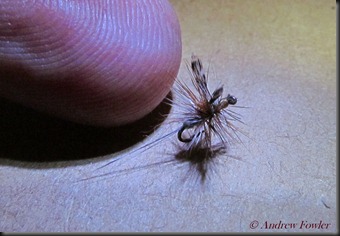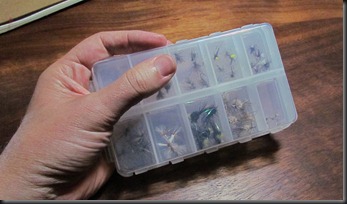I often marvel at the guys who buy their dry flies. Mostly I marvel at guys who buy dries for the second time. First time I can understand, but second time around….wow!
Now this sounds like an obscure thing to say, but have you seen the size of dry flies in tackle shops?
Generally the fly sizes start about a #10 or #12, and go down to a #16. If you are lucky, perhaps a #18.
Now that’s just fine if you are imitating a hopper, or in the case of the DDD, a dead stable rat, but lets consider the mayflies for a moment. And what about the caddis, and the midges?
Next time you are out on the water on one of those sticky summer evenings, when everything is hatching around you, blow some of those “miggies” out of your nose, and have a look at them. Measure them against the thumb nail of your small finger, or better still, prop one up beside a #18 imitation on your fly box. Looks a bit silly, doesn’t it!

Now go on a hunt. Look for the biggest mayfly spinner you can find. See if you can get one of those “great big” juicy pale yellow ones that you sometimes see.. I challenge you to find one bigger than a #16. I don’t believe I have seen one bigger than that in 20 years on the water, and in fact if I had to guess the average size, I would place it at smaller than #18.
Now go back to your tackle shop, and ask them for a selection of #20 dry flies, and watch them stutter and fumble. And if you bought your dries there the first time, may I ask what you are doing looking through the #12 dry fly bin?
Those big dry flies work of course. I caught my biggest trout on an imitation of a small deer. So perhaps I should not be berating the guy with his hand in the #12 cookie jar, but I’ll hold off so long as he doesn’t try to tell me that he is matching a hatch.
So far I have only mentioned dry flies, but what about nymphs. We have to assume that anything that hatches into a #20, must have been a #20 to start with. So how big are your general purpose nymphs, your “Hares Ears”, and “Pheasant Tails”?
Mine are far too big.
Like you, I like to tie something onto the end that will straighten the leader neatly on the water, and that can be seen with the naked eye. Now that probably explains why I fish with damsels and dragons so often. With those two I can put something on that is the size of a small car, and still claim to be imitating the natural.
If you look at my fly boxes nowadays, I hope you would not say “Wow but your flies are big” or “Gee! They are so small”, because you would need to say both those things at once. In the same way that my music tastes range from Bach to AC/DC, so my fly boxes contain everything from #20 to #2.

Coming back to those dry flies. Most of us baulk at even putting a #20 hook in the vice, let alone tying something onto it. Goddard and Clarke would also have us tie USD Para duns to match the hatch correctly. They tie these on huge hooks, by my standards, and rightly so, because their mayflies are huge. The mayflies on English Chalk streams grow up on a diet of creatin, and power builder. Those things obscure your vision as they fly by, and the trout have to chew before they can swallow, but what about our insects?
We have the unenviable task of trying to create a reasonably accurate imitation on the tiniest hooks.
The answer to this dilemma, I believe, lies in the Funnel dun method, invented by Neil Patterson. Patterson was never in opposition to the USD Para dun concept put forward by Goddard and Clarke in the early eighties, but he was motivated by the difficulty of tying, and the cost of grade A genetic capes, to try something different. By Goddard and Clark’s own admission, the Para dun was intended for that “special, well educated Trout”.
So for the common garden variety of trout, I propose the funnel dun. What’s more is that the funnel dun is a whole lot easier to tie on #18 and #20 hooks, than any other dry fly.
Patterson’s wonderful invention was quite widely publicised in the UK, but I wonder how many South Africans even know of its existence. Let me educate you.
The fly in question is actually not a fly. It is a dressing technique. Just about any conventional dry fly can be converted into the funnel dun style.
First off, lets dispense with the fly’s wing. That’s because this is a small hook, and we don’t want to complicate things.
The fly starts up at the hook eye, where you tie in a small ball of dubbing to match the body colour you have chosen. Next you move your silk to about the mid-point of the shank. Here you set about tying in an oversized, cheap and nasty Indian cape hackle. Once you have done that you pull all the fibres forward over the ball of dubbing, and wind your silk over the fluffy hackle butts, right up to the base of the ball.
This has the effect of splaying the hackle fibres in a forward facing funnel, over the eye of the hook.
Now return to the bend, where you tie in your tail, which MUST be tied in slightly around the bend, so that it does not protrude in line with the shank. Lastly start the body of the fly up over the bound-down hackles, and wind it down to the base of the tail where you do a whip finish.
Once you have tied off, remove this apparition from the vice, and snip out a ‘v’ in the hackle fibres, on the top of the shank. Now throw the fly on the table.
It should land upside down, hook point in the air, resting on its tail, and on the sides of the slanting hackle fibres (not the points). Its bum should be a fraction off the tabletop, and it will probably be smiling at you too!
It’s simple. It can be very small. It rides with the hook out of the water. It catches trout.